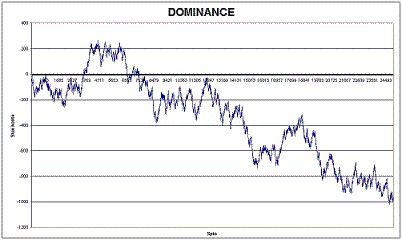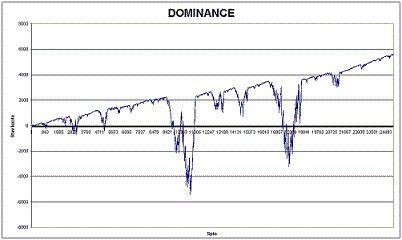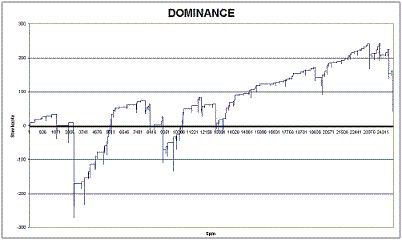The basic principle of the Dominance system consists of one selected six bettings. You choose a double street, for example with these numbers: 1 -2- 3- 4- 5- 6 and you bet only on this by using a progression. The progression is as follows: 1-1-1-1-1- 2- 2- 2- 3- 3- 4- 5 -6 -7. If you do not hit your six-figure line within 14 spins, you have a loss of 39 units and you start betting again from the beginning. If you win, your profit depends on which spin you hit your six-figure line.
What do the Statistics say?
To count an exactly expected profit is not so simple because a profit is different on each spin. Generally, we can assume that the probability of winning is 6/37 = 16, 22% on each spin. The probability of not hitting a six-figure line within 14 spins is 3114/3714 = 8, 40%. So it can result in a loss of about 26, 58 units per 100 spins, therefore we can make an estimate of a negative trend. A series of 25.000 spins is shown on the following graph.

The graph shows that in the long term this system (in this form) really went below zero. There were some positive moments and a loss was not so huge – a loss reached values of about 2000 units per 25.000 spins. We attempted to apply some modifications such as altering the length of the game (shortening or lengthening), but the system did not change. Never mind. We also attempted to apply a classical linear progression of series with expectations of some improvement:

As we had assumed, we observed an upward trend, but local slumps were presently reaching a loss of about hundreds of thousands of units, so it is very dangerous. In principle, this was a type of Martingale progression.
What else could we apply? We attempted to apply a waiting factor. It meant that we did not start betting until the roulette hit our double street at least 10 times or 20 times in a row. What was the result? You can see it in the following graph:


When we applied a waiting factor of 10, we did not observe any strong effect. When we applied a waiting factor of 20, there was a marked difference (the graph was typically “serrated”), but the slumps occurred very often and resulted in a loss of over 10.000 units. Also, there was a huge variability of the interval (in the case of betting on a certain six-figure line) therefore even if we were waiting a long time to hit, we had the certitude that we probably reached bigger losses. It follows that another problem is that the game would be frequently interrupted (because of these intervals). It leads that the system is not usable (due to the time spent by playing roulette and betting only two times per month...). But it can work well as a part of some complex systems using a bigger amount of gambling systems.
Moreover, we have prepared a roulette betting simulator, where you can try this system for free.

 EN
EN  čeština
čeština  Polski
Polski  Slovenčina
Slovenčina  Русский
Русский  Deutsch
Deutsch  Slovenski
Slovenski  Dutch
Dutch  Svenska
Svenska  Português
Português  Italiano
Italiano  Español
Español  Français
Français  Suomalainen
Suomalainen  Български
Български  Românesc
Românesc  Magyar
Magyar  Eesti
Eesti  Ελληνική
Ελληνική  Latviešu
Latviešu  Lietuvių
Lietuvių  やまと
やまと  中国
中国  Dansk
Dansk  Türkçe
Türkçe  ID
ID  Українська
Українська  한국어
한국어  Norsk
Norsk  Peter Sommer
Peter Sommer 






You have to be logged in to add a comment